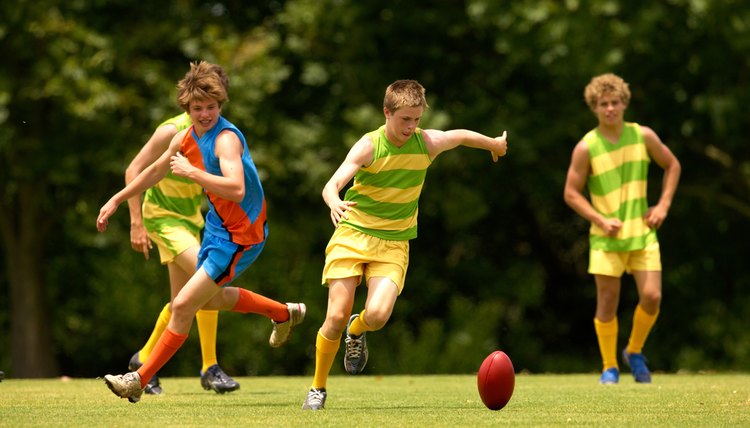The Muscle & Body Parts Needed to Kick a Football

Kicking a football, whether you are referring to American football or soccer, requires the activation of several key muscle groups. These include the core, hips, thigh and lower legs. Learning which muscles are involved is important for perfecting your kicking ability, as this will focus your mind on the correct muscles and motion. It is also important to learn the anatomy of your muscles because, well, they are a part of you.
Core
Your core -- the rectus abdominis, obliques and erector spinae -- is activated when you kick a ball to keep your torso upright. The rectus abdominis and erector spinae work to avoid your torso from collapsing forward or toward the back. As for the obliques, they are activated so your torso does not fall over to either side. The collective actions of all these muscles results in a balanced torso position.
Hips
Your hips, particularly your hip flexors and extensors, play a major role during kicking. The hip extensors, such as the gluteus maximus of your butt and the hamstrings of your rear thighs, allow you to wind your leg back. This is one of the first steps of kicking and allows you to start generating the force necessary for the ensuing kick. To bring your leg forward the opposing muscles, called the hip flexors, are activated. These muscles include the iliopsoas, tensor fasciae latae and pectineus. All of these muscles are located at the front of your hips.
Thighs
As previously mentioned, the hamstrings allow you to extend your leg. After the leg wind up, you will bring your leg forward to the kick the ball. In addition to the contraction of your hip flexors, your large quadriceps muscles will be activated to extend your knee. This powerful muscle group will bring your lower leg forward so you can kick the ball. During this knee-extending motion, another front thigh muscle, called the sartorius, will work alongside your quadriceps to externally rotate your knee, so you can kick with the ball with the inside of your foot.
Lower Legs
The remaining muscles that are mainly involved while kicking a football are the triceps surae and tibialis anterior. The former muscle group is activated while you whip your leg back initially, and the latter muscle is activated when you bring your leg forward. The triceps surae extends your ankle in the first phase of the kick. The tibialis anterior flexes it during the second phase.
References
Writer Bio
This article was written by the CareerTrend team, copy edited and fact checked through a multi-point auditing system, in efforts to ensure our readers only receive the best information. To submit your questions or ideas, or to simply learn more about CareerTrend, contact us [here](http://careertrend.com/about-us).
